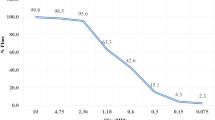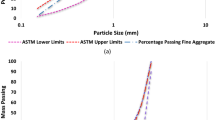Abstract
Steel scrap is a waste product of steel plate manufacturing industry. A large quantity of steel scrap is produced by drilling every year. The disposal of those steel scraps is a major issue in Iraq and all over the world. The landfill is one of the methods for disposing the scraps albeit it produces soil pollution. What is worse is that in Iraq there is no waste separation system in a sense that all the waste materials are dumped in soil especially in the desert, and it is harmful to the environment. One way to alleviate the situation, the present study suggests that steel scrap is added with concrete, and the mechanical and physical properties were studied. Waste materials, such as terrazzo tile and paving block, are dumped in landfills. Such action destroys the environment. Recycling these materials and using them as fine and coarse aggregate in new concrete mixes would eliminate the problem. Additionally, these waste materials are considered as non-degradable. Silica fume has been employed as a partial replacement by weight of cement at percentages of (8%, 12%, and 16%) to enhance the concrete that contains the waste materials. This paper examines the workability of addition of steel scrap to the weight of concrete by the percentages of (0.6%, 1.2%, and 1.8%) as well as the addition of porous tile and paving block as partial substitute by percentages of (15%, 30%, and 45%) for coarse and fine aggregate, respectively. Concrete samples were produced and subjected to compression strength, water absorption and split tensile tests. A reduction in strength was observed for all concretes that contain porous tiles waste as the percentage increased, in relation to the control concrete. On the other hand, concrete that contains waste paving blocks shows an increment in strength at the percentages of (15% and 30%) and reduction at the percentage of 45%. Based on the compressive strength test results, steel scrap samples being at 0.6%, 1.2%, and 1.8% show that the strength increased of the samples with 0.6% and decreased of those at 1.2% and 1.8%. Thus, this research demonstrates that the use of three waste materials-crushed tiles waste, steel scraps and paving blocks waste as components of concrete is technically feasible in the manufacture of concrete.






















Similar content being viewed by others
References
Chaboki HR, Ghalehnovi M, Karimipour A, Brito JD, Khatibinia M (2019) Shear behaviour of concrete beams with recycled aggregate and steel fibres. Constr Build Mater 204:809–827. https://doi.org/10.1016/j.conbuildmat.2019.01.130
Meddah MS, Bencheikh M (2009) Properties of concrete reinforced with different kinds of industrial waste fibre materials. Constr Build Mater 23:3196–3205. https://doi.org/10.1016/j.conbuildmat.2009.06.017
Adom-Asamoah M, Kankam CK (2008) Behaviour of reinforced concrete two-way slabs using steel bars milled from scrap metals. Mater Des 29:1125–1130. https://doi.org/10.1016/j.matdes.2007.06.001
Mertol HC, Baran E, Bello HJ (2015) Flexural behavior of lightly and heavily reinforced steel fiber concrete beams. Constr Build Mater 98:185–193. https://doi.org/10.1016/j.conbuildmat.2015.08.032
Mazloom M (2008) Estimating long-term creep and shrinkage of high-strength concrete. Cement Concr Compos 30:316–326. https://doi.org/10.1016/j.cemconcomp
Demir A, Topcu IB, Kusan H (2011) Modeling of some properties of the crushed tile concretes exposed to elevated temperatures. Constr Build Mater 25(5):1883–1889. https://doi.org/10.1016/j.conbuildmat.20
Lopez V, Llamas B, Juan A, Moran JM, Guerra I (2007) Eco-efficient concretes: impact of the use of white ceramic powder on the mechanical properties of concrete. Biosys Eng 96:559–564
Halicka A, Ogrodnik P, Zegardlo B (2013) Using ceramic sanitary ware waste as concrete aggregate. Constr Build Mater 48:295–305. https://doi.org/10.1016/j.conbuildmat.2013.06.063
Poon CS, Chan D (2007) The use of recycled aggregate in concrete in Hong Kong. Resources, Conservation and Reycling 50:293–305. https://doi.org/10.1016/j.resconrec
De Brito J, Pereira AS, Correia JR (2005) Mechanical behaviour of non-structural concrete made with recycled ceramic aggregates. Cement Concr Compos 27(4):429–433
Spanish Ministry of Environment (2001) Resolution of 14 June, that approves the national plan of construction and demolition waste 2001. [In Spanish] BOE 166:25305e25313
Guerra I, Vivar I, Llamas B, Juan A, Moran J (2009) Eco-efficient concretes: the effects of using recycled ceramic material from sanitary installations on the mechanical properties of concrete. Waste Manag 29:643–646. https://doi.org/10.1016/j.wasman.2008.06.018
Pacheco-Torgal F, Jalali S (2010) Reusing ceramic wastes in concrete. Constr Build Mater 24:832–838. https://doi.org/10.1016/j.conbuildmat.2009
Sanchez-de-Rojas MI, Frías M, Rodríguez O, Rivera J (2014) Durability of Blended cement pastes containing ceramic waste as a pozzolanic addition. J Am Ceram Soc 97:1543e1551. https://doi.org/10.1111/jace.12882
Anres J, Desiree R, Julia G, Manual IG, Julia MM (2018) Mechanical an microstructural characterization of non-structural precast concrete made with recycled mixed ceramic aggregates from construction and demolition wastes. J Clean Prod 180:482–493. https://doi.org/10.1016/j.jclepro.2018.01.191
Chouhan P, Jamle S, Verma MP (2017) Experimental investigation on silica fume as partial replacement of cement for M-25 grade concrete. Int J Sci Adv Res Technol. 3(5):714–717
ASTM-C150 (2016) Standard specification for Portland cement, annual book of ASTM standard. https://doi.org/10.1520/c0150-c0150m16
Ozcan DM, Bayraktar A, Sahin A, Haktanir T, Turker T (2009) Experimental and finite element analysis on the steel fiber-reinforced concrete (SFRC) beams ultimate behavior. Constr Build Mater 23(2):1064–1077. https://doi.org/10.1016/j.conbuildmat
ASTM-C494 (2004) Standard classification for chemical admixtures for concrete, https://doi.org/10.1520/c0494_c0494m-19
ASTM C 1240-05 (2005) Standard specification for silica fume used in cementitious mixtures american society for testing and materials standard practice, Philadelphia, Pennsylvania, USA
ASTM-C642 (2006) Standard test method for density, absorption, and voids in hardened concrete. https://doi.org/10.1520/c0642-06
ACI 211.1-91 (2009) Reapproved 2009, standard practice for selecting proportions for normal, heavyweight, and mass concrete, ACI committee report, American Concrete Institute 211
Acknowledgements
The authors would like to thank Mustansiriya University for their support and experimental assistance during this study work.
Author information
Authors and Affiliations
Corresponding author
Ethics declarations
Conflicts of interest
The authors declare that they have no conflict.
Ethical approval
All procedures were carried out according to ethical standards.
Informed consent
Does not apply to this kind of paper.
Rights and permissions
About this article
Cite this article
Sharba, A.A.K., Ibrahim, A.J. Evaluating the use of steel scrap, waste tiles, waste paving blocks and silica fume in flexural behavior of concrete. Innov. Infrastruct. Solut. 5, 94 (2020). https://doi.org/10.1007/s41062-020-00341-8
Received:
Accepted:
Published:
DOI: https://doi.org/10.1007/s41062-020-00341-8




